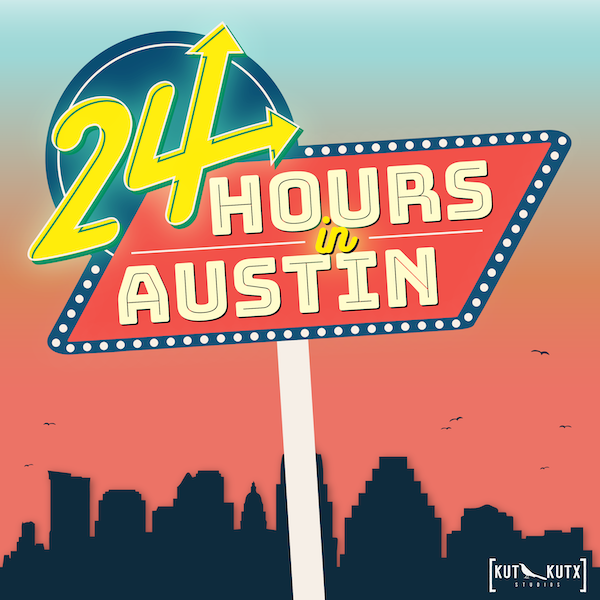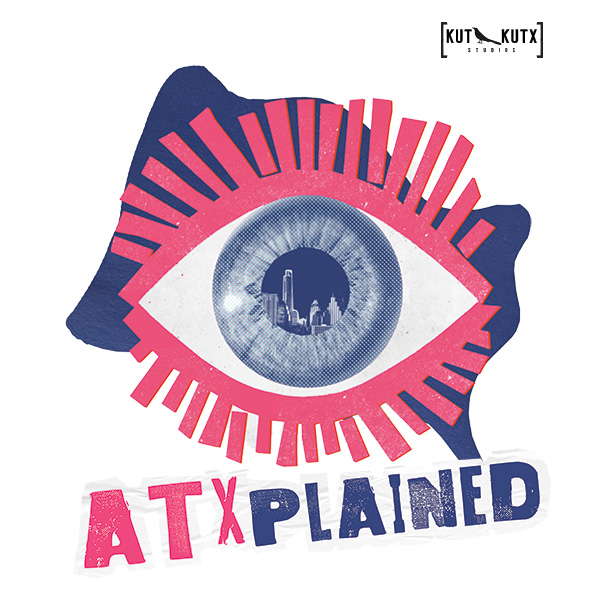The City of Austin cut $95 million from its budget, shrinking funding to parks, homelessness services and more after voters rejected Prop Q. We’ll get into how these cuts may impact you.
With recent rain and an overnight flood watch in Travis, Williamson, and Hays counties, many residents are reminded of the July 4 floods and the ongoing efforts to rebuild.
Plus, art groups seeking affordable studio space find sanctuary in a downtown Austin church. We’ve got more on how they secured the space and what that means for the arts community.
Also, Jason Mellard shares a new story from the archive of Texas music history.
The full transcript of this episode of Austin Signal is available on the KUT & KUTX Studio website. The transcript is also available as subtitles or captions on some podcast apps.
Miles Bloxson [00:00:09] Austin cuts $95 million from its budget, shrinking funds to parks, homelessness services and more after the fallout from Prop Q. Find out how those cuts affect you. And for folks in Sandy Creek, efforts to clean up after the July 4th floods are still ongoing. We’ll hear about ways you can help. Plus art groups seeking affordable studio space find sanctuary in a downtown Austin church. We’ve got more on how they secured the space and what that means for the Austin arts community. Coming up.
KUT Announcer Laurie Gallardo [00:00:41] The Austin Signal is a production of KUT News, hosted by Miles Bloxson. And Jason Miller brings us this week in Texas Music History. That’s next on Austin Signal.
Miles Bloxson [00:01:10] Hi there Austin. It is Friday, November 21st. Finally Friday. I know what you’re thinking. The weekend is almost here. I’m Miles Bloxson. This is the Austin Signal and thanks so much for joining us here today. A quick headline to start, the Austin Independent School District Board of Trustees early this morning approved a plan to close 10 schools and relocate dual language programs. The move is expected to help the district generate more than $20 million, eliminating its 19.7 million dollar budget deficit. Superintendent Matias Segura says the district will discuss in the spring another plan to close more schools and redraw attendance boundaries. That plan could be voted on next fall. The AISD board also voted to approve turnaround plans for 12 campuses that receive three consecutive failing or unacceptable grades from the state. You can find more on that plan at KUT.org. The city of Austin cut $95 million from its budget last night during its city council meeting. The cuts happened after Prop Q failed to pass this past election. Prop Q would have raised property taxes to generate $110 million in additional funds for the city. The original budget passed by city council in August had already factored those funds into the new budget. So with voters rejecting Prop Q, cuts to the budget had to be made. The breakdown where the cuts were made, We have City Council reporter, Luz Moreno-Lazano here joining us. Luz, great to talk with you. Hi, Miles. So with City Council initially factoring this $110 million into their budget before it was approved by voters, this feels a little like counting your eggs before they hatch, shall we say? Is this normally how things are done when it comes to the budget?
Luz Moreno-Lozano [00:02:58] What is normal, you know, like what is normal anymore? You know, typically the city council does adopt a budget and a tax rate to support that budget. And in it, they build things like, you now, they put in money for police and fire and parks and libraries. And yes, this time around, they knew that they wanted to do more with some of the money and they had to ask voters to do it. So. You know, depending on, you know, what the city council is trying to do that particular year, normally the tax rate is large enough. Now, you now, things are a little complicated this year with like the end of federal funding and property tax rate caps, and all of that has kind of factored into like a limited amount of revenue that the city was able to generate.
Miles Bloxson [00:03:41] Okay, and initially they had a
Luz Moreno-Lozano [00:03:42] plan for that $110 million, right? That’s right, that’s right. Yes, they had originally planned to cover a lot of things. One of the biggest chunks of it was to support homelessness services. They were gonna do shelters and rapid rehousing and permanent supportive housing and they had all of these plans to support homelessness. They were also focused on public safety and park improvements. And so all of that was part of this 110 million.
Miles Bloxson [00:04:07] So now they cut 95 million. Is that all from where they had hoped to use those Prop Q dollars?
Luz Moreno-Lozano [00:04:12] Yeah, I think so. I think, you know, they, they kind of went through and were like, okay, we, we had plans for this 110 million. We’re gonna have to either slash all of it or figure out how to make things work and move them around and subtract from other areas to support some of their priorities. So they ended up slashing a 95 million, they are moving some money over from their reserve fund, which is essentially like a city savings account to kind of help offset things but They made it very clear from the beginning that they had a couple of main focus areas and that included EMS services, making sure that they have enough to keep ambulances staffed. That included homelessness efforts and that was like, you know, it’s not every piece of homelessness that they hoped, but it was some. And they wanted to have 24 hour coverage for people who are in mental health crisis and having people be able to respond to that. And so they were really focused on those main priorities and so they… Kind of came in and were like, this is how much money and what we need to do and what we need work with within the budget that we have.
Miles Bloxson [00:05:11] Where else were things cut-
Luz Moreno-Lozano [00:05:13] Yeah, you know, parks saw a pretty big cut. You know, part of the 110 million was wanting to fund new staff to maintain parks and grounds maintenance. You know we’ve seen the city wanting to invest more in green spaces and we just don’t have the staffing to maintain them. Originally they were hoping to fund 60 new positions and now that has dwindled down to like 15. You know, some of the homelessness services that they were hoping to add on to included rapid rehousing and included bridge sheltering. So those kinds of things were all part of it. I think one of the other big things was like EMS in addition to staffing was also supposed to get new equipment and other things that were going to help them as you’re trying to sustain and grow their department. And that was also part of some of cuts we saw yesterday.
Miles Bloxson [00:05:59] And how will this affect us folks living here in Austin? I mean, you named a number of things there, but.
Luz Moreno-Lozano [00:06:04] What are the big things? I think EMS is probably going to be the biggest one. And when you think about it, you don’t think about EMS all the time, right? You’re really only calling 911 when there’s an emergency, and it might be one of your worst days. But if you do call 911, you want them to be able to respond as quickly as possible. And so that’s one of the biggest things that this is doing is, how can we ensure that the ambulances across the city are fully staffed? So that they can respond in a timely manner. They did say that there are more things that they need to be doing to kind of improve that response time, but that’s probably the biggest one. Also like homelessness, I think a lot of people are concerned with people living unhoused and trying to solve that problem means giving people access to shelter and services to help them do that. And so we’ll start to see some of these things kind of come into fruition this year with this budget.
Miles Bloxson [00:07:01] You know, Luce, I’m not a mathematician, but they plan for an additional $110 million, but they only cut $95 million. Are there more cuts to come?
Luz Moreno-Lozano [00:07:11] There aren’t. So they moved that money from their reserve fund that we kind of talked about earlier. So, I mean, you know, the city council does have that money there for a rainy day. And so, you know, they weren’t as thrilled as, as they wanted to be in, in moving some of that money over, but it does help kind of fund some of these high top priorities. So.
Miles Bloxson [00:07:29] We’ve been speaking to Luz Moreno-Lezano, City Council reporter for KUT. Luz, thanks so much for talking to us. Thanks, Miles. With this past rain and flood watch, Travis, Williamson, and Hayes County were under a small watch until early this morning. It would absolutely make sense if memories of July 4th floods come to mind, but for some of us, those reminders of that tragic day are more lasting as the cleanup from wrecked home and property persists. KUT’s Williamson County reporter, Kailey Hunt, has been following these ongoing cleanup efforts. She joins us today. Kailey, how are you today?
Kailey Hunt [00:08:09] I’m alright Miles, how are you?
Miles Bloxson [00:08:11] Doing great! So what is happening this weekend?
Kailey Hunt [00:08:14] Yeah, so this weekend the Austin Disaster Relief Network is holding a cleanup event in Sandy Creek. That’s a community located just outside of Leander in Northwestern Travis County. They’re among the hardest hit areas during the July storms and floods. 10 people died, over 200 homes were damaged or completely lost. So they are asking for volunteers to come out. For one big last push to try to clean up some properties for these folks before the Thanksgiving holiday. And you’ve been keeping up.
Miles Bloxson [00:08:46] With these folks since the floods, what’s been going on with them?
Kailey Hunt [00:08:49] Yeah, so, you know, we’re nearing five months now since the disaster happened. Many, many of the residents that I’ve spoken to in the Sandy Creek area are actually still homeless, technically. You know, they’re still living in trailers or even tents out on their properties that still have debris buried three, four feet into the ground. So they are, you now, still awaiting some disaster relief funds. And trying to work through what their next steps are going to be.
Miles Bloxson [00:09:20] So it’s still a lot of work to be done. Absolutely. And you’ve talked with Sarah Ashworth, a lead volunteer with the Austin Disaster Relief Network, and this was during a cleanup a few weeks ago. Let’s listen to what she had to say about these cleanups.
Sarah Ashworth [00:09:39] Almost three four foot higher than it was all this settlement and and all it like this tiles and glass and it’s just like it wasn’t there and then we’ll find you know animal bones and Obviously, initially there was bones being found…
Miles Bloxson [00:09:57] And what are other volunteers saying about this?
Kailey Hunt [00:10:02] Yeah, so you heard from Sarah there. She’s a really involved volunteer. She’s been there since the initial days after the disaster. During that cleanup too, I also met with a lady who actually drove in four hours from the Houston area just for a Saturday cleanup. And she says, for her, it’s really important because she herself is a disaster survivor and she knows that recovering. From these types of events, you just can’t do it alone. You have to have community, you have to volunteers. And so that was her big message that she wanted to get out to the community.
Miles Bloxson [00:10:37] Yeah, volunteers are definitely important and you know, we’re almost in December and it’s about to possibly get colder and we just had thunderstorms in the area with a flood watch. Is there any additional urgency to get things cleared before the weather gets, you know ugly?
Kailey Hunt [00:10:52] Absolutely. Yeah. You know, I mentioned obviously folks want to get some properties cleaned up before the Thanksgiving holiday, but I think the more pressing issues, like you said, it’s been raining. It’s been stormy. The RVs and even tents, I don’t know if you’ve ever been camping in the rain, they leak, right? Like they leak water. So, you know, folks are in uncomfortable physical, you, know, just situations. And then to add onto it, you know, lots of folks are still traumatized. So every time it rains or thunderstorms, you know, it brings back memories of the July floods. And so, yeah, there is some urgency to try to help these folks get a new homes.
Miles Bloxson [00:11:32] And Kailey, you just came into the studio straight from a rally that was happening in front of the Capitol about disaster relief. What was going on there? That’s right. Yeah, we were.
Kailey Hunt [00:11:40] Actually across the street from the Capitol in front of the governor’s mansion. Yeah, so there were dozens of flood survivors from Sandy Creek, along with survivors from Hurricane Harvey as well, just people from all across the state. They are coming together and asking the governor to establish a $500 million disaster relief fund for just Texans to provide them with immediate, you know, direct monetary relief. For folks who who survive these these types of events and they’re asking him to create that fund using money from the rainy day fund, right so They say transferring over money from The Rainy Day Fund for an actual rainy day
Miles Bloxson [00:12:25] Yeah, that’s what it’s for, right? And I know we talked about this earlier in our conversation, but remind us, what is going on this weekend with Austin Disaster Relief Network?
Kailey Hunt [00:12:34] Yeah, so just to put it out there again, Austin Disaster Relief Network, they are gonna hold a big cleanup event in Sandy Creek. You can go onto their website to learn more just about who’s eligible to volunteer. Most everybody, if you’re above the age of 16, can volunteer. What types of supplies you need, closed-toe shoes, gloves. And yeah, sign up, figure out what you can do out there and help people out.
Miles Bloxson [00:12:59] And what’s been your biggest takeaway from like being in the space with these people like going through what they’re going through?
Kailey Hunt [00:13:05] Yeah, you know, it’s tough. I grew up in Leander, just around the, only like five, 10 minutes away from these folks who were affected by the floods in Sandy Creek. It’s emotional every time you go out there. The biggest thing I just want people to know is, is yeah, it has been four or five months, you know down the road since the disaster first struck, but people are still struggling. They need help. There’s a lot of unanswered questions, just a lot uncertainty about. The future for these folks, and yeah, we want to make sure that we share those stories.
Miles Bloxson [00:13:38] Thank you so much. And we’ll have a link with the Austin disaster relief network information in today’s podcast, show notes at kut.org slash signal. We’ve been speaking with KUT’s Williamson County reporter, Kailey Hunt. Kailey, thanks so much for talking with us today. Thanks, Miles. Up next, we’ll hear from the Austin Creative Alliance about how they secured their new home, and we’ll here from Jason Mellard with This Week in Texas Music History. This is Austin Signal, I’m Miles Bloxson and welcome back. Finding affordable studio space is a constant battle for Austin artists. It’s a fight that sometimes ends with a musician or non-profit being pushed out of town, but it doesn’t always end in a loss. From the KUT’s art desk, Stephanie Federico reports on one of those victories.
Stephanie Federico [00:14:31] John Reedy can already see how it’s all going to come to life.
John Reedy [00:14:33] This is going to be a lot of kids lessons and rehearsals for dance concerts. There’s a piano in here that’s going to stay.
Stephanie Federico [00:14:41] He’s walking me around the campus of a historic church downtown. Reedy is the CEO of Austin Creative Alliance, a nonprofit formed in 1974 to support the city’s arts community. The group lost its longtime East Austin home in May after the building was sold and rents went up. Nine artists and three nonprofits were displaced. It’s a familiar story, but this one’s got a better ending. Austin Creative alliance was able to find a new space in just a few months and for less money than it had been paying. It’s renting two floors from Central Christian Church. In turn, it’s subletting studio space to artists and cultural groups.
Pastor Lane Beamer [00:15:18] We’re going to help them maintain this beautiful historic space. And they’re going help the arts community access affordable space.
Stephanie Federico [00:15:26] How did it all come together? Austin Creative Alliance was connected to Central Christian Church through art. Pastor Lane Beamer had been an actor in California. He met Reedy a few years ago through a friend of a friend he had done plays with in the 90s. The two of them hit it off.
John Reedy [00:15:42] It was a very just coincidental serendipitous connection.
Stephanie Federico [00:15:46] The two floors in the church building have been used by a performing arts school for about a decade. After the school closed shop three years ago, the church rented it out to a real estate firm. Then it moved out and the church had a blank slate. When Austin Creative Alliance was looking for a place to relocate, it reached out to see if they had space available.
Pastor Lane Beamer [00:16:04] And I said, boy do we, come take a look.
Stephanie Federico [00:16:08] That’s Pastor Beamer.
Pastor Lane Beamer [00:16:09] And so when we walked with John and started talking about who might want what room, we really let go of the notion of what’s been and said, well, what do the artists need?
Stephanie Federico [00:16:22] It was a puzzle figuring out who should go where, based on lighting, room size, and function, but the new tenants all had one need in common, affordable studio space. Rent varies for each of the 13 studios in what’s now called the sanctuary. Reedy says it comes to around $3 per square foot per month, all utilities included. For comparison, space in the Canopy Arts Building in East Austin is around $30 a square foot. Sharon Anderson is the founding executive director of ATX Theater. One of the group’s subletting studio space.
Sharon Anderson [00:16:54] There are lots of places where you can put on a concert or practice whatever, but there are not a lot of places that people who make performances can afford to rent. ATX Theater moved into a 660 square foot room on the second floor earlier this month. It’s going to require some adjustments of course, like for example that is clearly not a sound proof door, and we’re going to have people singing and dancing and doing all kinds of things in here, so we just moved in. She plans to rent the space out for rehearsals. You can imagine all those cool, funky little garage band theaters, you know, that often rehearse in their backyard because they can’t afford the expensive rehearsal spaces. They’re gonna be pretty excited to get a space for $10 an hour instead of 25. Makes a big difference. Hopefully that extra 15 bucks will go to pay actors or get nicer costumes or something. Beamer is glad the space is going to be used.
Pastor Lane Beamer [00:17:48] It has a spirit and I think it’s been feeling a little neglected. And so I really do believe that if buildings and rooms have their own spirit, the building is happy.
Stephanie Federico [00:18:05] He says the church has not always been a welcoming place, and he wants to quote, do damage control for Jesus. He hopes Austin Creative Alliance’s presence will help bring neighbors in to see what’s going on.
Pastor Lane Beamer [00:18:18] That evangelism today is just letting people know you’re a Christian and not being a jerk. The opportunities to have people come in and out of here and have a pleasant experience and be supported and nurtured. The idea of sanctuary. Sanctuary not just for the religious community that’s at the heart, you know, of the church, but we’re really to be a safe space for everybody.
Stephanie Federico [00:18:43] The new tenants started moving in this month and all the studios should be full by the end of the year. I’m Stephanie Federico in Austin.
Miles Bloxson [00:18:57] Texas has so much music history. We learn something new all the time or every week with the help of Jason Mellard from the Center of Texas Music History at Texas State.
Jason Mellard [00:19:15] This week in Texas music history, free jazz from Fort Worth hits the spot. On November 17th, 1959, one of the more legendary opening nights in jazz history took place. Ornette Coleman’s quartet debuted at the Five Spot in New York City. The Fort Worth-born saxophonist was joined on stage by Don Cherry, Charlie Hayden, and Billy Higgins and supported their revolutionary Atlantic Records LP, The Shape of Jazz, to come. Informed by bebop, rhythm and blues, and Ornette’s homilotic philosophies, the quartet was greeted by a collection of hipsters, aficionados, and even skeptics, all curious to see what this new turn in free jazz was all about. As Coleman described his innovations later in the liner notes of his 1960 release, Change of the Century, the members of my group and I are now attempting a breakthrough to a new, freer conception of jazz, one that departs from all that is standard and cliché. The Five Spot, located at Cooper Square, just off the then-run-down Bowery, was already a hotspot for the newest in jazz when they booked pianist Cecil Taylor in 1957. But Ornette’s arrival was a downtown sensation. Lines snaked around the block, and celebrities of the creative world like James Baldwin and Robert Rauschenberg found their way to the packed venue. The original two-week booking extended well into 1960. Coleman’s stand at the Five Spot proved to be a pivotal moment in jazz and creative improvised music. Marking a shift in musical consciousness and practice that continues to resound in Texas and across the globe. You can hear music from the Lone Star State 24-7 on the Texas Music Experience at TMX.fm.
KUT Announcer [00:21:15] Support for This Week in Texas Music History comes from Brain Audio, maker of a compact portable speaker featuring an internal subwoofer that produces deep bass sound. Engineered in the live music capital of the world, more at BrainAudio.com. That’s B-R-A-N-E audio dot com.
Miles Bloxson [00:21:36] Don’t forget, you can take Austin Signal with you wherever you go, just go to kut.org slash signal and subscribe to the podcast or search Austin Signal in your favorite podcast app and listen that way. Austin Signal is made possible because of the work of the trusted reporters and music aficionados here at KUT News, KUTX, Texas Standard and the Texas Newsroom. Thank you for spending part of your day right here with us at the Austin Signal. We are listener supported public radio. On air live at KUT News at 90.5 on the KUT app and online at Kut.org slash Signal. That’s where you can listen to previous episodes of Austin Signal and at KUt.org you’ll find the daily reporting from the KUT newsroom. And that’s it for today on Austin Signal. Kristen Cabrera is our managing producer. Rayna Sevilla is our technical director. And I’m Miles Bloxson. This is Austin Signal
This transcript was transcribed by AI, and lightly edited by a human. Accuracy may vary. This text may be revised in the future.





